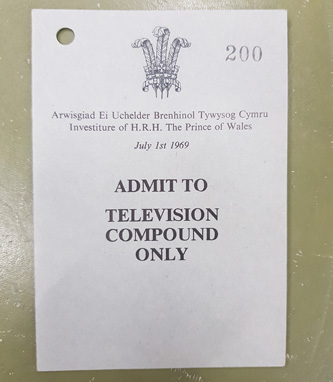Here’s the second in a three-part story of how the investiture of Prince Charles as Prince of Wales was secured, in the months before the world’s eyes were on Caernarvon Castle in July 1969.
‘Box 500’ – the official code-name for the Security Service- set out to the Ministry of Works how to do passes. They should be numbered, with an expiry date; and include a passport-size photograph, gummed to the pass and marked with a stamp; signed for, and in a sealed, plastic envelope. The Security Service gave the HMSO (official government printer) contact details, to supply the materials, and portable equipment to make the passes. The Ministry estimated it would need 400 permanent passes, and 250 temporary.
The authorities plainly kept an eye on the newspapers, because the file WORK 21/147 includes cuttings, such as from the Liverpool Daily Post of November 13, 1968, reporting RAF lights around the castle; and police with guard dogs were seen patrolling outside.
As for the press, the Ministry noted that reporters visiting the castle as ‘sponsored parties’ beforehand would not need a pass each, if they were escorted by a pass holder. What about parcels delivered to the castle in the run-up to the investiture? If someone did not sign for one, the gate-keeper would arrange for collection, or else record the parcel as suspect and call in the police. The normal Caernarvon Castle entrance was the King’s Gate; others were to be kept locked.
The Security Service judging from the file plainly kept an interest in the operation, because they wrote to the Ministry in December 1968, that they hoped to visit in the new year, and wished to appoint one of the works staff as a part-time security officer, to deal with the police.
HMSO was printing passes at their press at Harrow in north London, under ‘security conditions’. Again, the Security Service attended to detail. As discussed with ‘Box 500’, the pass had a background of yellow and rose, and words in black. As workmen would handle the passes (in other words, wear and tear them), passes would have plastic cases.
On January 3, 1969, the Ministry proposed a security lock and chain on the Wicket Gate, the side gate opposite the main King’s Gate; and a battery-operated loud-hailer. On January 10, 1969, the Security Service’s director for Wales told the Ministry in Cardiff that he would like to see two extra gatemen; and the Royal Welch Fusiliers had offered some soldiers. But, it turned out that the Fusiliers could not make good on their offer because they would be stationed in Dorset. The Ministry was trying to recruit two extra gatemen; one probably to become the third ‘custodian’ at the castle. The Fusiliers were looking into recommending ‘suitable ex-servicemen’.
The castle needed more telephones, for example at a first aid post at the King’s Gate, and the prince’s robing room in Chamberlain’s Tower. Still in January 1969, the Security Service advised that all passes should expire by June 30. That is, new passes would come in from July 1, to the day of the investiture. While the Security Service did not elaborate, presumably that was to avoid the risk of people whose business inside the castle had expired, still accessing. ‘Box 500’ was already thinking of a search of the castle before the ceremony, as ‘an essential precaution but a difficult one’. And ‘Box 500’ warned the Ministry of the possibility that intruders might wear police uniform. Police should be asked to show their warrant card.
On February 4, the Security Service admitted a loophole in their access card. A newsreel cine-cameraman needed background shots, and would have to wait for the right weather; he would need a day pass, and would not be escorted.
On February 12, the Ministry sent the Security Service director for Wales a pass of his own. A cutting from the South Wales Echo of February 13, 1969, made it into the file; that five Welsh castles, including Caernarvon, were scaled in the night, to publicise Swansea University’s rag week. Students dangled a banner and a rag t-shirt. The students were foiled at Cardiff Castle, because the gate-keeper heard them and turned on the searchlight. The report implied without saying so that Caernarvon Castle did not hear their intruding students. The Ministry made a statement to the press, that the banner at the Eagle Tower of Caernarvon was removed before daylight by the police, though students got in, by scaling scaffolding at Queen’s Gate. The Ministry wrote to the Coventry scaffolding firm on February 20, complaining that several scaffolders had turned up and been let in by the gate-keeper without passes; and some had not applied for a pass.
Later that month, the scaffolding company dismissed a man because his records didn’t check out. A photo he had taken for his pass showed him with a flower in his hair. The (named) man complained to his union, but had a bad police record, and a probation officer.
Next: count-down to the day.
Pictured; label that admitted one person to the ‘television compound only’ at the investiture, part of the National Archives file WORK 21/147.










